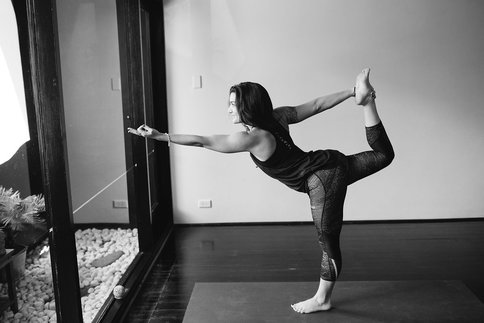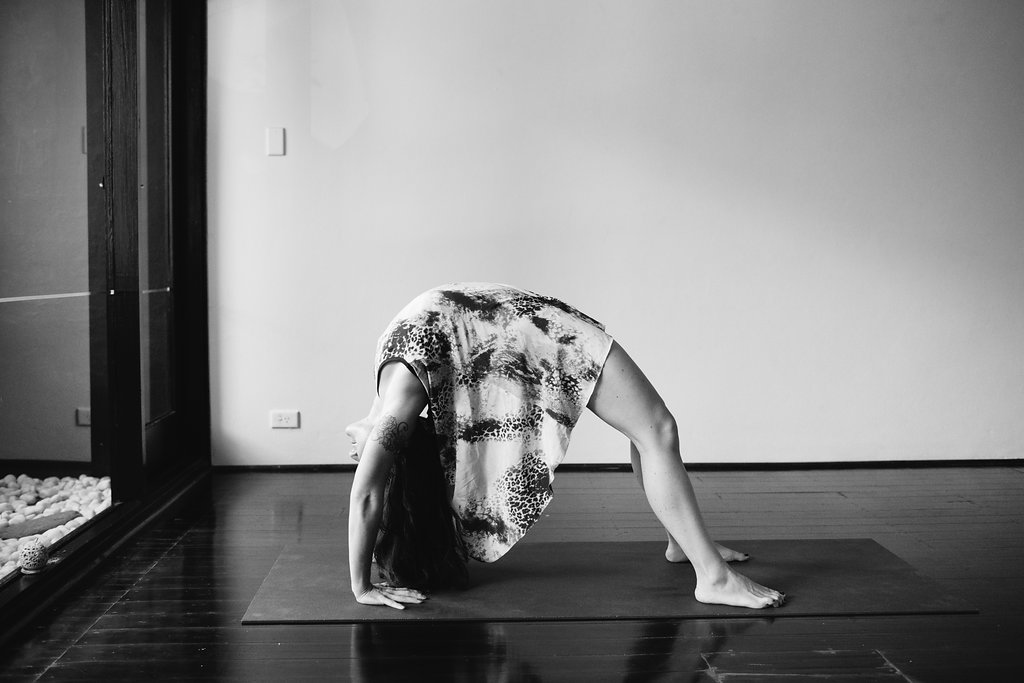|
Each week smile in the sky feature a different yoga pose and 5 physical health benefits and 5 mental health benefits related to it
This week…dancer’s pose. [Sanskrit translation: Natarajasana: Nata (dancer), raja (king), asana (pose)]. This pose is typically performed at the end of a series of challenging backbends. It requires stable balance, engagement of the standing quad and hamstring, open hip flexors, a strong core and a flexible back. A challenging pose with many variations. See here for a preparatory sequence. 1. Physical benefit: HIP FLEXOR STRETCH Strong hip flexors are necessary to do this pose safely (see here for a series to strengthen the hip flexors), however flexibility is central to allow the back leg to float higher, creating a pleasant stretch for the stomach and front body. Mental benefit: INCREASED CONFIDENCE All back bends are really more accurately named ‘front openers’, and the opening of the chest and widening of the collarbones displays vulnerability and openness. As the connection between the body and mind goes both ways, improved posture can have a correlated positive effect on levels of self-confidence. See here for a report on fascinating research exploring the impact of assuming ‘superhero pose’ and the positive effects on self-esteem via lowering of cortisol levels. 2. Physical benefit: HAMSTRING STRETCH Stability is found in the pose through distributing the weight evenly across all four corners of the foot of the standing leg while keeping the kneecap engaged, rising from this solid base. There is dual and opposing action: of activation in the front of the leg, allowing for increased stretch in the back side of the leg. This can be likened to Newton’s Law of physics: ‘for every action there is an equal and opposite reaction’. Mental benefit: IMPROVED FOCUS AND CONCENTRATION Keeping attention focused on a drishti: either the breath, or on one point above the eyeline will help to keep you steady in the pose. A good rule: if you look down, you’ll go down! 3. Physical benefit: SHOULDER OPENING As you kick back with the back leg, elbow straight, the inner shoulder receives a lengthening stretch, helping to serve as an antidote to the hunched shoulders we often adopt while at computers, driving etc. Mental benefit: IMPROVED NERVOUS SYSTEM FUNCTION A central highway for communication between the brain and body, and the body back to the brain: the spinal cord gets a stretch in this pose. The vagus nerve, central to the Parasympathetic Nervous System, also finds stimulation in this pose. This can be maximized through the use of full deep breathing using the diaphragm. 4. Physical benefit: BALANCE Simply standing on one foot can be very challenging for beginners to yoga. Happily, as the body and brain learn which muscles to engage to maintain balance, more advanced variations are available. Mental benefit: CALMER MIND This elegant pose may be a rare opportunity to explore the softer, more feminine side of your practice. Smooth transitions maintain the mind’s focus and allow for a smooth flow of movement and focused consciousness, allowing the mind to quiet. See here for a short article on meditation. 5. Physical benefit: CORE STRENGTHENING Engage the deep abdominal muscles to maintain stability in the pose and help create balance in the hips. Mental benefit: EMOTIONAL RELEASE The opening of the hips created through kicking back into the hand with the back leg while tilting forward can be a powerful release for tension held in the hips. In yoga the hip area is commonly referred to as storing emotional memories and release can often have people pouring with tears (this is a great way to rid the body of excess cortisol: the stress hormone, which is toxic in high levels). See here for an article on the science of tears. Next week there will be no blog release due to the Easter long weekend. Have a great break everyone! We’ll be back the week after with a new blog series…watch this space! To learn more about the mind-body connection and ways to improve your mental health see www.smileinthesky.com for workshops for mental health, yoga, and research consultancy.
0 Comments
Each week smile in the sky feature a different yoga pose and 5 physical health benefits and 5 mental health benefits related to it
This week…wheel pose. [Sanskrit translation: Chakrasana: chakr (wheel), asana (pose)]. In yoga it is said that your age is determined by the flexibility of the spine. In this pose there is nowhere to hide in this regard! Chakrasana displays the beauty and the art of yoga: there is always more to explore. Once you have mastered the wheel, you can experiment with walking the arms or legs in, try some dropbacks, and other extensions of this pose. Go slowly and with the instruction of a qualified teacher to avoid injury. 1. Physical benefit: SHOULDER FLEXIBILITY This pose requires a high level of openness (and strength!), in the shoulders. Stretches against a wall (see no.3), can get deep into the muscles on the interior of the shoulder joint, in the underarms. See here for 16 stretches for tight shoulders. Downward dog, performed correctly, drawing the chest to the frontal thigh can help prepare these deep muscles for this back bend. Mental benefit: INCREASED ENERGY Wheel can be stimulating and invigorating, due partly to the massage given to the spinal cord: the nerve bundle located next to the spine that along with the brain makes up the Central Nervous System. A great pose to work up to if you’re feeling sluggish, however not recommended in evening classes if you fancy an early night! 2. Physical benefit:FRONTAL BODY STRETCH The openness in the chest and lungs allows for maximum lung capacity to improve oxygen intake and C02 expulsion. Breathing long and deep ujjayi breaths will increase endurance in the pose and provide essential support for this strong back bend. Mental benefit: INCREASED ALERTNESS Inversions allow for blood to flow more freely to the head, potentially increasing the level of oxygenated blood reaching the brain. This may assist focus and concentration. See this article for how exercise can make your brain work better. 3. Physical benefit: HIP FLEXOR FLEXIBILITY Strengthening of the hip flexors is crucial to protect these muscles/tendons and balance the stretch. See here for a preparatory sequence from the wonderful Rod Stryker. Mental benefit: CONQUER FEARS Opening the chest and heart can be a challenging experience for many who may feel vulnerable in this pose. See here for a Brene Brown’s TEDTalk with a different perspective on the positives of allowing yourself to be vulnerable, a central tenet of this inspiring woman’s teaching. Wheel pose can be a great way to face fears and boost your confidence. 4. Physical benefit: SPINAL FLEXIBILITY SACRUM TO SKULL The obvious benefit of working towards this pose is increased mobility in the spine. With time and practice the hands can walk closer to the heels and vice versa, heightening the bend. Mental benefit: SELF RELIANCE Continued efforts to master this pose, displaying determination in unfamiliar circumstances can increase resilience and improve our sense of self-reliance, increasing trust in ourselves to commit to the practice and efforts needed to achieve our goals. See here for more tips on how to improve your self-reliance. 5. Physical benefit: WRIST STRENGTHENING At first, many experience wrist pain in yoga due to the high level of weight bearing on the hands, from chaturanga dandasana, downward dog, to hand balances and beyond. It is best to gradually increase the length of practice, having breaks when necessary, and ensuring you perform counter poses and counter stretches wherever possible. With practice, as the tendons and muscles strengthen, the strain in the wrists will lessen and drop away. See here for a wrist – free yoga sequence and here for some wrist relaxers. Mental benefit: EMOTIONAL RELEASE Places in our bodies where we hold tension and tightness are typically where we are holding psychological energy. Opening the heart and releasing stiffness in the shoulder blades may allow for a release of emotional tension. Enjoy experimenting with wheel pose, safely, and do a gentle or stronger forward bend counter-pose appropriate to your ability. To learn more about the mind-body connection and ways to improve your mental health see www.smileinthesky.com for workshops for mental health, yoga, and research consultancy. Next week…dancer’s pose [atarajasana] |
Details
Harriet Sciberras
Director and Founder of smile in the sky. Archives
April 2017
Categories |
SMILE IN THE SKY


 RSS Feed
RSS Feed
